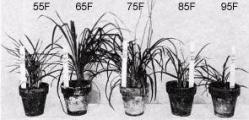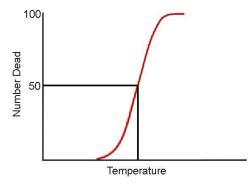@Terry thank you, for the information about the dormants growing well in your conditions.
The following is information about heat stress and I want to emphasize that I would never expect daylily growers to do experiments so this is just to provide general information to help understand some of the ins and outs of heat stress.
Arisumi did a designed experiment testing how temperature affected daylily growth. There is no doubt that temperatures of 85F and 95F caused problems. The experiment was done under certain controlled conditions and not under normal growing conditions in a field or garden. When a plant is growing in normal garden conditions there are many other factors that will affect how a plant will react to high temperatures, other than the maximum daily temperature.
For example, how quickly a maximum temperature is reached will affect a plant's response. How long the maximum temperature is maintained will affect a plant's response. The relative humidity, the wind speed, the amount, time and depth of any daily shade, the amount of rainfall, the amount, time and method of any watering, the depth of any leaf debris (soil temperatures are significantly modified by dead leaves on the surface, for example), all will have effects on how the plant responds to the maximum temperature.
Although maximum temperatures are important in determining heat stress, the actual pattern of the temperatures is also very important. As an example, suppose 85F caused some stress, 75F caused no stress and 95F caused much stress. Twenty consecutive days of 85F would cause a certain amount of stress. Ten days of 95F followed by ten days of 75F might cause more stress than twenty days of 85F. However if there were 20 days of 12 hours of 75F at night and 12 hours of 95F in the day then there might well be no stress (the cooler night might allow recovery of some to all of the daily stress). Yet if those temperatures were reversed so that the 95F was at night and the 75F during the day there might be even more stress than for the ten days of 95F followed by ten days of 75F.
The symptoms of heat stress depend on the level of heat stress that the plant experiences. One symptom may be pollen infertility, another might be pod abortion, or pod infertility, etc. Other symptoms may be early leaf yellowing and summer dormancy. Summer dormancy may be a daylilies attempt to escape heat stress and/or drought.
One also has to keep in mind that daylilies are genetically different in all characteristics. When it comes to temperatures, daylilies will have different minimum temperatures at which they die (lower lethal limit). They will have different maximum temperatures at which they die (upper lethal limit). They will have different lower temperatures at which they start and stop growing. They will have different growth rates as temperatures change. They will have different optimum temperatures for growth and probably different optimum temperatures for pollen fertility, pod fertility, leaf death (senescence), etc.
There has been more than sixty years of daylily selection during which there were significant changes in the proportions of daylilies hybridized in the south versus the north. That may have had effects shifting temperature ranges one way or another.
Below is a photo of the plants Arisumi grew at the different temperatures. It is easy to see that 65F was near the optimum for growth.

Below is a graph showing an example of what one would expect if one tested the effect of temperature on a group of 100 different cultivars looking for what temperature killed half of the cultivars. That is marked as 50 and is called the LT50 - the lethal temperature that kills 50% of the population. Temperatures below the lethal limit but somewhere above the optimum temperature for growth cause visible heat stress.

Below is a graph showing two hypothetical daylily cultivars with different lower and upper limiting temperatures for growth and different optimum temperatures.



